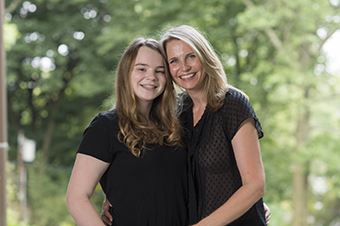A Montclair teen anticipates getting back in the saddle after several surgeries to repair a serious liver injury.

Hadley Skule had been struggling with Lyme disease that left her feeling exhausted and unable to be active most days. In October 2017, the 14-year-old from Montclair had finally been officially diagnosed with Lyme and started a treatment plan of antibiotics that had her feeling well enough to get back to her favorite pastime—horseback riding.
“She went to her riding lesson, and it was the first time the whole family was there to watch her,” remembers her mother, Samantha Skule. “Then in the last five minutes, we heard everyone gasp, and saw her on the ground unconscious.”
Her mother didn’t see the fall, but suspected the horse may have bucked, knocking Hadley to the ground. Her father raced to her side as bystanders called for an ambulance. Hadley was dazed, repeatedly asking what time it was and complaining that her shoulder hurt.
A Serious Injury Discovered
She went to the nearest hospital where the doctors did scans of her head and shoulder without finding an injury. “When they finally did a CT scan of her abdomen, the doctor’s face went white as a sheet,” Samantha says. “He said she had a grade 4 liver laceration, and they couldn’t treat her there.” The shoulder pain she was feeling was actually a symptom of severe internal bleeding.
Hadley was loaded into a helicopter and flown to The Bristol-Myers Squibb Children’s Hospital (BMSCH) at Robert Wood Johnson University Hospital, a pediatric trauma center. “An important lesson I learned from this is how important it is for parents to know the location of their nearest pediatric trauma center,” Samantha says. “Once we arrived at RWJUH, it felt like she was in good hands.”
All the Right Resources
“When Hadley arrived, we recognized that she would need the highest level of care available,” says Joelle Pierre, MD, Medical Director of Pediatric Trauma, BMSCH and Rutgers Robert Wood Johnson Medical School. “We were able to offer her all of our resources, from interventional radiology and gastroenterology, to the intensive care unit and the blood bank. The nuance of solid organ injuries is knowing when to operate versus when to aggressively observe the patient. This involves careful monitoring with quick response to changes in status.”
Yi-Horng Lee, MD, Chief of Pediatric Surgery, BMSCH and Rutgers Robert Wood Johnson Medical School, and Shaheen Timmapuri, MD, Assistant Professor of Surgery, BMSCH and Rutgers Robert Wood Johnson Medical School, worked alongside Dr. Pierre on Hadley’s case. “They told us she was one of the most challenging liver patients they had treated,” Samantha says. “And that her injury was very serious.”
Together, Hadley’s care team determined that they had to stop the bleeding in her liver before they could safely operate to repair the injury. “Our interventional radiologist was able to embolize the bleeder,” says Dr. Lee. “You just can’t effectively treat trauma patients without specialized services like this one for injured children. We are fortunate to have that.”
Once Hadley was stabilized, repairing the damage to her liver required a series of procedures including placing a drain to allow the bile to come out into a bulb instead of staying inside the abdomen to be infected. Because of this, she had a lengthy hospital stay. After a month, her liver was still leaking bile, but Dr. Pierre decided it was better to wait and see if she healed rather than do more procedures. “I was so grateful they decided to send us home with a liver drain so Hadley could be home for Christmas,” Samantha says. “And their wait-and-see strategy worked, as she slowly improved.”
Back to the Life She Loves
Today, Hadley’s liver is on the mend and she’s getting back to normal, even looking forward to horseback riding again someday. Samantha says she and Hadley are planning to revisit her care team at The Bristol-Myers Squibb Children’s Hospital for the one year anniversary of the accident. Hadley’s father, who works for NASDAQ, hopes to have the doctors out to ring the market bell.
“The silver lining of this whole episode was the positive experience we had at The Bristol-Myers Squibb Children’s Hospital,” Samantha says. “They do this kind of work every day at the highest level, with incredible care and compassion. I’ll be forever grateful for everything they did for our family.”
The Bristol-Myers Squibb Children’s Hospital at Robert Wood Johnson University Hospital was the first hospital in New Jersey to achieve pediatric trauma center verification. Read More.
What is a Pediatric Trauma Center?
A pediatric trauma center is verified by the American College of Surgeons, and this designation means that the hospital has the proper personnel, infrastructure and equipment to deal with severely injured children. The pediatric specialists available include surgeons, orthopedists, neurosurgeons, anesthesiologists, intensivists and radiologists. They all collaborate to care for injured children, from the initial response to final rehabilitation. The operating room, interventional radiology suites and blood bank are ready at a moment’s notice to deal with life-threatening situations.
To learn more about The Bristol-Myers Squibb Children’s Hospital at RWJUH, visit rwjbh.org/bmsch.